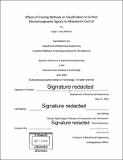Effects of training methods on classification on surface electromyographic signals for myoelectric control
Author(s)
Day-Williams, Hugh C
DownloadFull printable version (3.722Mb)
Other Contributors
Massachusetts Institute of Technology. Department of Mechanical Engineering.
Advisor
Leia Stirling.
Terms of use
Metadata
Show full item recordAbstract
Myoelectric devices, devices which use the electric signals from human muscles as a control scheme, have shown promise in their potential to aid in human movement augmentation and assistance for those that have suffered injury. Previous studies involving myoelectric devices and the classification of surface electromyographic (sEMG) signals, electrical impulses obtained from muscles from sensors on the skin, have sought to use various types of machine learning models for sEMG pattern recognition. This technique shows promise in being able to accurately classify human sEMG signals and map them to certain movements, which can then be used as a method of myoelectric control. In this study we explored how two methods of training a K-Nearest Neighbor (KNN) classifier, used to control a MyoPro arm orthosis, affect two subjects' performance on various experimental tasks and their measured sEMG activation throughout the tasks. It was found that for subject 1, the assisted training method, where another individual helps move the orthosis while training the KNN, resulted in a lower variance in the measured mean sEMG values, and reduced the cross validation accuracy of the controller, but did not reduce subjects' performance of the experimental trials, as compared to the KNN controller trained without assistance. For subject 2, the assisted controller reduced the performance on three out of the four tests performed compared to the unassisted controller.
Description
Thesis: S.B., Massachusetts Institute of Technology, Department of Mechanical Engineering, 2018. Cataloged from PDF version of thesis. Includes bibliographical references (page 25).
Date issued
2018Department
Massachusetts Institute of Technology. Department of Mechanical EngineeringPublisher
Massachusetts Institute of Technology
Keywords
Mechanical Engineering.
